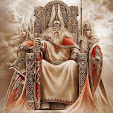In Norse mythology, Thor is a hammer-wielding god associated with thunder, lightning, storms, oak trees, strength, the protection of mankind, and also hallowing, healing and fertility. The cognate deity in wider Germanic mythology and paganism was known in Old English as Punor and in Old High German as Donar, stemming a Common Germanic (meaning "thunder").
Thor is a prominently mentioned god throughout the recorder history of the Germanic peoples, from de Roman occupation of regions of Germania, to the tribal expansión of the Migration Period, to his high popularity during the Viking Age, when, in the face of the process of Christianization of Scandinavia, emplems of his hammer, Mjölnir, were worn in defiance and Norse pagan personal names containing the name of the god bear witness to his popularity.
Into the modern period, Thor continued to be acknowledged in rural folklore throughout Germanic regions. Thor is frequently in rural folklore thoughtout Germanic regions. Thor is frequently referred to in place names, the day of the week Thursday ("Thor´s day; old English Thunresdaeg, Thunor´s day) bears his name, and names stemming from the pagan period containing his own continue to be used today.
In Norse mythology, largely recorded in Iceland from traditional material stemming from Scandinavia, numerous tales and information about Thor are provided. In these sources, Thor bears at least fourteen names, is the husband of the golden-haired goddess Sif, is the lover of the Jötunn Járnaxa, and is generally described as fierce-eyed, red-haired and red-bearded. The same sources list Thor as the son of the god Odin and the personified earth, Fjörgyn, and by way of Odin.




